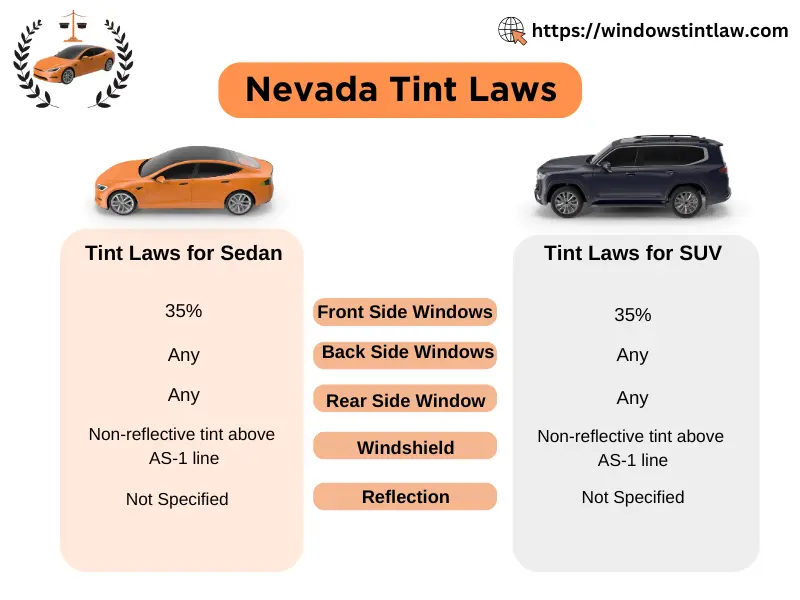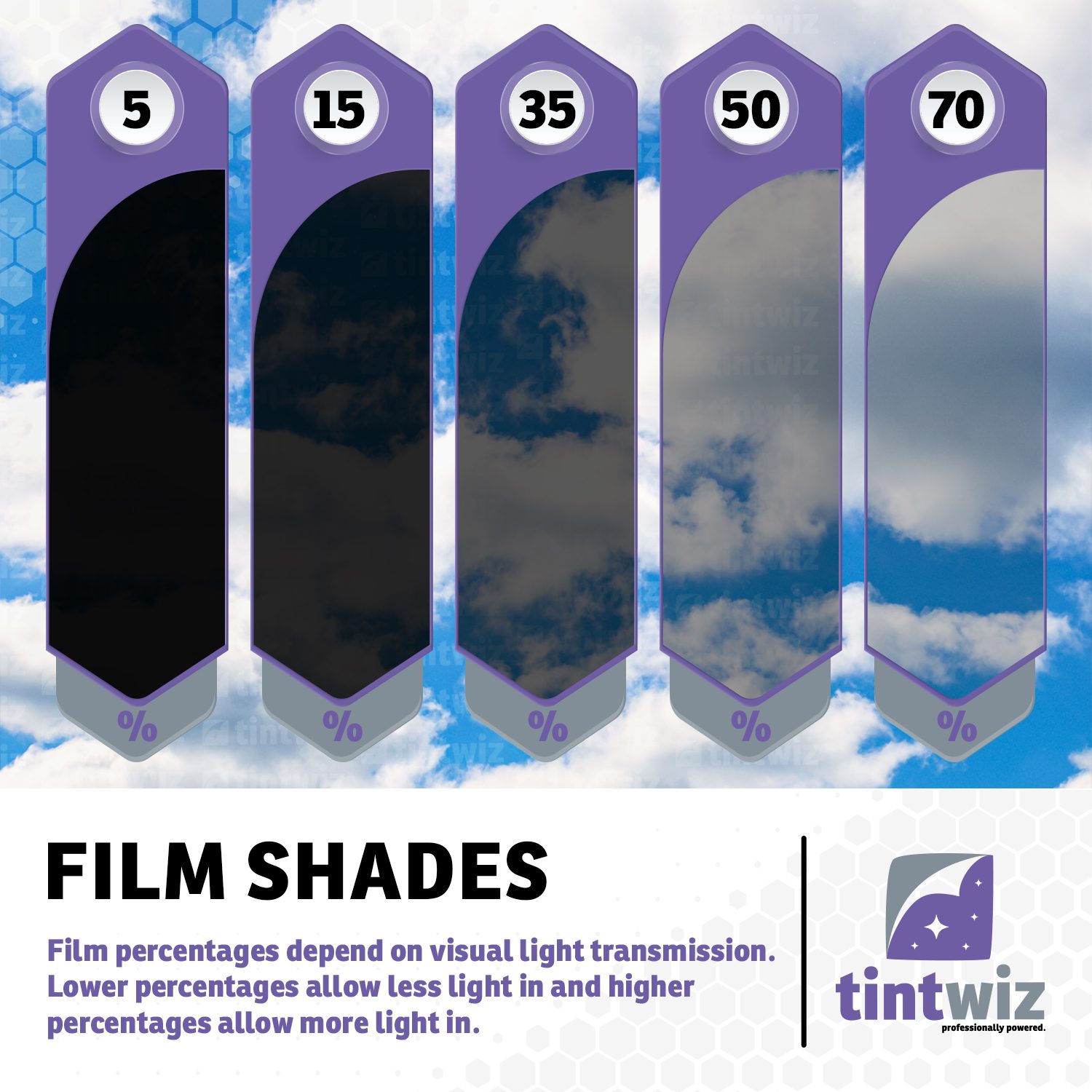As an Amazon Associate, I earn from qualifying purchases
Understanding Nevada car tint laws is essential for drivers. These regulations ensure safety and compliance on the road.
Nevada’s sunny climate often leads residents to tint their car windows. While tinting can offer benefits like reducing glare and heat, it’s important to follow state laws. Nevada has specific rules about how dark and reflective your car window tint can be.
Knowing these laws helps avoid fines and ensures your car meets legal standards. In this blog post, we’ll break down the key points of Nevada’s car tint laws. This will help you make informed decisions about tinting your vehicle. Stay compliant and enjoy a safer driving experience in Nevada.

Credit: windowstintlaw.com
Introduction To Nevada Car Tint Laws
Nevada car tint laws are essential for vehicle owners. These regulations ensure safety, visibility, and comfort while driving. Understanding these laws helps you stay compliant and avoid penalties. This article will guide you through the important aspects of Nevada car tint laws.
Why Tint Laws Matter
Car tint laws protect drivers and passengers. They ensure clear visibility on the road. This reduces accidents and enhances road safety. Tint laws also prevent excessive glare from the sun. This keeps the driver’s vision unobstructed.
Additionally, these laws help law enforcement. They allow police to see inside vehicles. This is crucial for safety during traffic stops. Tint laws also protect against harmful UV rays. This preserves the interior of your vehicle and protects your skin.
General Tint Regulations
Nevada has specific rules for car window tinting. These rules cover different aspects:
- Windshield: Non-reflective tint is allowed above the manufacturer’s AS-1 line.
- Front Side Windows: Must allow more than 35% of light in.
- Back Side Windows: Any darkness can be used.
- Rear Window: Any darkness can be used.
Reflective tint is also regulated. Front and back side windows must not be more than 35% reflective. Ensure your tint installer is aware of these rules. This will help you remain compliant with state laws.
For vehicles like SUVs and vans, there are special rules. These vehicles have different visibility requirements. Make sure to check specific regulations for your vehicle type. This ensures you follow the law correctly.
Staying informed about these laws is crucial. It helps you avoid fines and legal issues. Always choose a reputable tint installer. They will ensure your tint meets Nevada regulations.

Credit: www.cartintlaw.com
Legal Tint Percentages
Nevada has specific car tint laws to ensure safety and visibility. Knowing the legal tint percentages can help you avoid fines. This guide will break down the allowed visible light transmission and specific tint limits for different windows.
Allowed Visible Light Transmission
The state of Nevada regulates car window tints by the percentage of visible light transmission (VLT). This percentage measures how much light passes through the window. The higher the VLT, the more light passes through. In Nevada, different windows have different VLT requirements.
- Windshield: Non-reflective tint is allowed above the manufacturer’s AS-1 line.
- Front Side Windows: Must allow more than 35% of light in.
- Back Side Windows: Any darkness can be used.
- Rear Window: Any darkness can be used.
Specific Tint Limits For Different Windows
Each type of window on your vehicle has its tint limit. This ensures that drivers have clear visibility and can safely navigate the roads.
| Window | Allowed Tint Percentage |
|---|---|
| Windshield | Non-reflective tint above AS-1 line |
| Front Side Windows | More than 35% VLT |
| Back Side Windows | Any darkness |
| Rear Window | Any darkness |
Staying within these limits ensures your car complies with Nevada’s laws. It also helps maintain safety on the roads.
Exceptions And Special Cases
Understanding Nevada car tint laws is essential for all vehicle owners. These laws ensure that drivers have clear visibility and maintain safety on the road. However, there are some exceptions and special cases where the rules might differ. Let’s dive into the specific circumstances where Nevada car tint laws may not apply.
Medical Exemptions
Some drivers in Nevada may qualify for medical exemptions. These exemptions allow for darker window tints due to health reasons. Conditions such as lupus or other skin conditions that require protection from the sun may qualify. To obtain a medical exemption, a driver must have a signed statement from a licensed physician. This statement should specify the medical necessity for a darker tint.
The exemption must be carried in the vehicle at all times. Law enforcement officers may ask to see this document during a traffic stop. It is important to ensure the exemption is valid and up-to-date. This helps avoid misunderstandings and potential fines.
Vehicles With Factory Tint
Many vehicles come with factory-installed tints. These tints are usually within legal limits. However, it is important to be aware of how much light is allowed through. Factory tints are often lighter than aftermarket tints.
If you are unsure about the tint on your vehicle, it is best to check. A professional can measure the tint and ensure it complies with Nevada laws. Vehicles with factory tints may still need to adhere to specific guidelines. This ensures that all vehicles on the road are safe and compliant.
By understanding these exceptions and special cases, drivers can stay informed. This helps maintain safety and avoid unnecessary penalties.
Tint Certification And Labeling
Understanding Nevada’s car tint laws is crucial for vehicle owners. Compliance ensures safety and avoids penalties. One key aspect is tint certification and labeling. This section covers the essentials you need to know.
Certification Requirements
Nevada requires specific certifications for window tints. These certifications ensure the tint meets state standards. Manufacturers must certify the film they sell. Dealers should provide a certification sticker. This sticker proves the tint is legal.
Not all tints qualify. Only those meeting specific Visible Light Transmission (VLT) percentages pass. Check your tint’s VLT before purchase. Certified tints have documentation. Keep this documentation for future reference.
Label Placement Guidelines
Label placement is equally important. The law requires labels on each tinted window. These labels must be visible and legible. They should be placed between the tint and the glass. This placement makes them easy to inspect.
The label must include the manufacturer’s name. It should also state the VLT percentage. Ensure labels are intact and readable. Damaged or missing labels can lead to fines. Always check labels after installation.
Penalties For Non-compliance
Driving with illegal window tint in Nevada can lead to serious consequences. Complying with Nevada car tint laws is important. Violations bring penalties that affect your wallet and your driving record.
Fines And Penalties
Non-compliance with Nevada car tint laws results in fines. First-time offenders may face a fine of up to $200. Repeat offenders can expect increased fines. The second offense may cost up to $500. A third violation can lead to fines up to $1,000. These penalties serve as a deterrent. They emphasize the importance of following the law.
Process For Addressing Violations
When caught with illegal tint, a police officer will issue a citation. You must address this citation promptly. Ignoring it can lead to further complications. To resolve the citation, you may need to appear in court. During the court hearing, you can present your case. The judge will decide the outcome based on the evidence.
If found guilty, you must pay the fines imposed. It is also necessary to remove or adjust the illegal tint. Failure to do so can result in additional penalties. Keeping your vehicle compliant prevents these issues. Regular checks ensure your tint meets Nevada’s legal standards.
Choosing A Compliant Tint
Choosing a compliant tint for your car in Nevada is crucial. It ensures you stay within the law and keeps you safe. Understanding the types of legal tint and finding a reputable installer are key steps.
Types Of Legal Tint
In Nevada, specific rules govern car window tinting. It’s essential to know these rules to avoid penalties.
| Window | Allowed Tint |
|---|---|
| Front Side Windows | Must allow over 35% of light in |
| Back Side Windows | Any darkness is allowed |
| Rear Window | Any darkness is allowed |
| Windshield | Non-reflective tint above the AS-1 line |
Finding A Reputable Installer
Choosing the right installer ensures your tint complies with Nevada law. Here are the steps to find a reputable installer:
- Research: Look for local installers with good reviews.
- Certifications: Ensure the installer is certified.
- Experience: Ask about their experience with Nevada tint laws.
- Warranty: Check if they offer a warranty on their work.
Following these steps helps you avoid fines and ensures your car looks great.
Future Changes In Tint Laws
The future of Nevada car tint laws might see some changes. As technology advances and public opinion shifts, legislators could update existing regulations. These changes aim to address safety, health, and technological concerns. Understanding potential updates and staying informed will keep you compliant.
Potential Updates
Lawmakers might consider new technology when updating tint laws. Advanced films can now block harmful UV rays without darkening windows. This could lead to relaxed rules on tint darkness. Another potential update is the consideration of medical exemptions. People with certain health conditions might get special permissions for darker tints.
There’s also a push for uniformity across states. This means Nevada might align its laws with neighboring states. This would make it easier for drivers who travel across state lines. Public safety is always a top concern. Any updates will likely focus on ensuring clear visibility for drivers and law enforcement.
Staying Informed
Staying updated on tint law changes is crucial. Regularly check official state websites for announcements. Join local car forums and communities. They are great sources of information and discussion. Subscribe to newsletters from automotive associations. These often provide updates on law changes and compliance tips.
Consult with professional tinting services. They stay informed about the latest regulations. They can ensure your car remains compliant. Ignorance of the law is not an excuse. Staying informed will save you from potential fines and legal trouble.

Credit: tintwiz.com
Frequently Asked Questions
What Are Nevada’s Car Tint Laws?
Nevada law permits a 35% VLT on front side windows. Rear windows can have any darkness. Windshield tint is restricted to the top 5 inches.
Can I Tint My Front Windshield In Nevada?
Yes, you can tint the top 5 inches of your front windshield. The rest of the windshield must remain clear.
Are There Medical Exemptions For Car Tint In Nevada?
Yes, Nevada allows medical exemptions for car tint. You need a doctor’s certificate to qualify for an exemption.
Is Reflective Tint Allowed In Nevada?
Nevada law permits a certain level of reflectivity. Front and back side windows can have up to 35% reflective tint.
Conclusion
Understanding Nevada car tint laws helps ensure your vehicle stays compliant. Stay aware of the regulations to avoid fines. Legal tints enhance privacy and reduces glare. Check tint percentages before installation. Following these guidelines keeps you on the right side of the law.
Always consult a professional for accurate advice. Happy driving!
As an Amazon Associate, I earn from qualifying purchases


